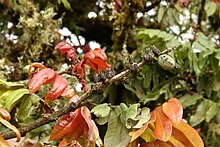Alfaroa costaricensis, also known as campano chile, chiciscua, gaulin, gavilán Colorado,[1] or gavilancillo, is nut bearing timber tree in the Juglandaceae family. It is native to the Neotropics, from Mexico, through Central America to Colombia.
| Alfaroa costaricensis | |
|---|---|

| |
| Scientific classification | |
| Kingdom: | Plantae |
| Clade: | Tracheophytes |
| Clade: | Angiosperms |
| Clade: | Eudicots |
| Clade: | Rosids |
| Order: | Fagales |
| Family: | Juglandaceae |
| Genus: | Alfaroa |
| Species: | A. costaricensis
|
| Binomial name | |
| Alfaroa costaricensis | |
Habitat
editAlfaroa costaricensis normally grows in cloudy areas on well-drained soils with slopes of 5% or more at elevations between 600 and 2200 m which receive 1500–2500 mm of precipitation and sustain temperatures of 15 to 20 °C. This tree does not grow well in the shade.
Description
editAlfaroa costaricensis is a slow growing tree with pink heartwood. It can reach 27 m in height and 60 cm diameter at breast height (d.b.h.).[2]
The seed is a nut, one-chambered at the apex and eight-chambered at the base, which measures 1.6 to 2.5 cm long and 1.4 to 1.6 cm in diameter, and is protected by a hard, thick, brown pericarp. Germination is hypogeal. The leaves are pinnately compound, and are distinguishable from other species by their heavy pubescence. The male inflorescences is a panicle, consisting of approximately ten catkins arranged alternately. The female flowers are sessile on a catkin.[3]
Uses
editTimber
editAlfaroa costaricensis wood is attractive but difficult to saw and finish. It is used for furniture, posts, building lumber, and the production of charcoal.[2]
Wildlife food
editRodents consume many nuts.
References
edit- ^ Giddy, Ian. (2004). Alfaroa costaricensis (Gualín, campano chile) Archived 2009-04-02 at the Wayback Machine. Cloudbridge.
- ^ a b Arnáez, E.; Moreira, I. (2002). "Alfaroa costaricensis Standl.". In Vozzo, J.A. (ed.). Tropical tree seed manual - Part II, Species descriptions (A to C). Agriculture Handbook. Vol. 721. U.S. Dept. of Agriculture, Forest Service.
- ^ A picture of a female inflorescence can be found at Alfaroa costaricensis PlantSystematics.org. A line drawing of a branch with leaves and of female flowers can be found in Arnáez, E.; Moreira, I. (2002). "Alfaroa costaricensis Standl.". In Vozzo, J.A. (ed.). Tropical tree seed manual - Part II, Species descriptions (A to C). Agriculture Handbook. Vol. 721. U.S. Dept. of Agriculture, Forest Service.. A picture of a complete tree can be found at Cloudbridge Archived 2009-04-02 at the Wayback Machine.
- Manos, P. S., and Stone, D. E., "Evolution, Phylogeny, and Systematics of the Juglandaceae", Annals of the Missouri Botanical Garden, '88(2) 2001, 231–269.
External links
edit- Media related to Alfaroa costaricensis at Wikimedia Commons
- Data related to Alfaroa costaricensis at Wikispecies